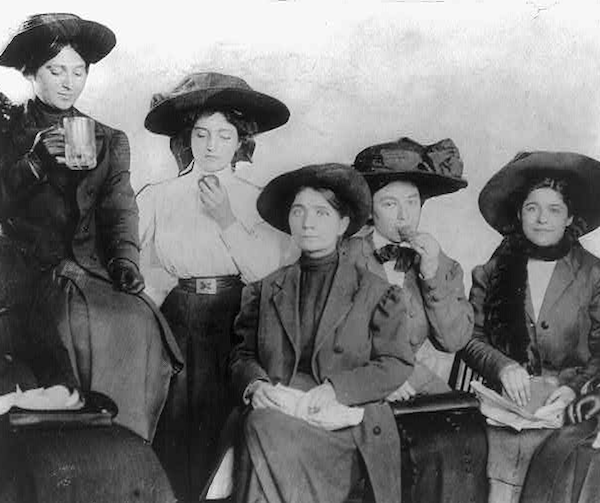
Our ancestors shape who we are today.
Their characteristics and personality traits are carried in us genetically and they live on through our cellular memory.
Let’s trace those wonderful characters from our family trees to discover our origins and uncover the fascinating roles they played throughout history.
My great-grandma was born in 1892 in the village of Hindley, Lancashire. Her name was Sarah Helen Green and she came from a land of cobbled streets and rows of two-up, two-down terraced houses, purpose-built for local cotton mill workers, coalminers, and their families.
She was the local knocker-upper. This was her profession, and one prevalent during the period. The knocker-upper did what the name suggests—knocked on windows to get people up for work in the morning. Many couldn’t afford an alarm clock, and they weren’t widely available, so the knocker-upper woke them up instead.
She would use a long wooden stick, made of bamboo, with hand-made bristles at the end, created long enough to reach the upstairs bedroom windows. She tapped on the glass to awaken the sleeping occupants within.
On occasion, the knocker-upper would use a pea shooter, a thin tube, to blow hard dried peas at the window. Often, the knocker-upper would hang around to ensure that the lazier inhabitants, who were prone to snoozing, actually did get up.
A human alarm clock, you might say.
Grubby, flat-capped, wooden clog-wearing inhabitants that included men, women, and children over the age of 10, would be seen marching over the cobbles each morning to their daily workplaces in the collieries and mills where they would often remain for up to 10 hours a day, six days a week.
I was amazed when my dad first told me about my ancestry and proud to learn about how my great-grandma had contributed to the social history of old Lancashire.
Many of us are not aware of what our ancestors achieved throughout their lives and many of the stories are lost from generation to generation, kept quiet, or perhaps misunderstood. We can discover so much about ourselves through our ancestors with a little research. Maybe we all have intriguing ancestors, just waiting to be revealed and written about.
My great-grandma married Thomas Dootson during the reign of King George V and bore one child in 1920, my grandfather. He was named Sydney—and grew up to be a professional footballer.
The last mill in Sarah’s village Hindley, where I grew up, closed in 1934 and by the 1950s, the role of the knocker-upper was in decline. At this time Sarah Helen was retiring and later that decade she also became a widow. By then she had two grandchildren, my dad and his younger sister, both born during the baby boom of the late 1940s.
The last knocker-upper in Britain finally surrendered in 1973, a year before I was born, the profession by then, long since obsolete. I remember the last clog maker’s shop in Hindley—Walter Hurst and Son—a popular family business that finally closed their doors after 103 years of traditional Lancashire clog making.
Sarah Helen probably hadn’t anticipated living to see the 1970s as females of her generation and status usually only lived into their sixties or seventies. Nor had she ever dreamed that she would live to see great-grandchildren.
When my mum was pregnant with me, she would visit Sarah Helen each week and they would share their lunch together, known as “dinner” in Lancashire. They would exchange stories whilst awaiting my delivery.
In her twilight years, although now weak, Sarah Helen became a great-grandma, and her dying wish was to meet me. I was her first great-grandchild. It was 1974.
I finally arrived in late July, during Lughnasadh, the Celtic festival that marks the beginning of harvest time. The two of us, my great-grandma and I, were in the same hospital. My mum was about to give birth in the maternity unit and Sarah Helen was in the geriatric ward at the opposite end of the building.
My mum endured a long and complicated delivery. In the days that followed my birth, requests for nurses to take me to my great-grandma were not considered a priority. My mum was not strong enough to leave the ward and logistics and paperwork won.
The wish to see her first great-grandchild was not granted. Sadly, I was not placed into my great-grandmothers arms while she was alive. Questions remain within me.
Perhaps the nurses didn’t quite understand the urgency? Maybe Sarah Helen wasn’t well enough for visitors? Perhaps the story has become misconstrued over time?
But my great-grandma lived to the ripe old age of 82 and outlived many of her friends and family. And she did, of course, live to be a great-grandma.
To this day, I have only seen two photographs of her, both black and white, but her memory lives on within everything I do. My mum says I would have loved her ways, which she describes as similar to mine.
My dad has told me about the Victorian boots she wore. They had the traditional toilet-bowl heel, above ankle in height, with long laces tied tight, and she wore them every day for as far back as he can remember. They peeked out from under her long skirts, her shirt tucked inside those skirts and a woollen shawl over the top. It was typical of the period and would compliment her outfit.
She wore a flowery apron each day for cooking and my dad says she made the “best chips ever!” cooked in a hot chip-pan containing a huge lump of lard. In the 1950s my dad was one of the best fed children at school because he went to grandmas at dinner time for a big chip butty!
We never really know ourselves until we reveal who our ancestors were and what they accomplished. And we never know what we might find. We can start by asking our family members or looking at old photographs. We could even research our family tree online.
We simply never know until we start what a journey of discovery may bring! Are you even vaguely curious about your past connections? Why not start today?
I feel connected to Sarah Helen and I’ve always been fascinated by the Victorian and Edwardian era, the tales of old Lancashire, and its mill towns and collieries. I love the architecture of the period, the social history, the clothes, and the footwear.
I’ve spent many years searching for a pair of black polished leather boots with a toilet-bowl heel, just like Sarah Helen wore. The very image of them, to me, is one of beauty and nostalgia for what they represent. They elude me however, and none of the boots fit the vision in my head.
And so, Sarah Helen Green, who would have thought I would marry into a family named Greenland? I now carry both of your surnames; your married name Dootson and your maiden name, Green.
I’d love to come and find you in the green land where you now reside—a land beyond those cobbled streets, chimney tops and windows that you once tapped on with your long stick. I’m proud to be a knocker-uppers great-granddaughter, and I look forward to our long awaited meeting.
In the meantime, I’ll keep searching for your boots.
~
Author: Shelley Dootson-Greenland
Image: Wikimedia
Editor: Lieselle Davidson










Read 3 comments and reply